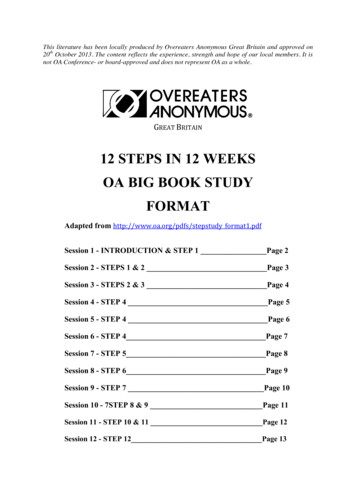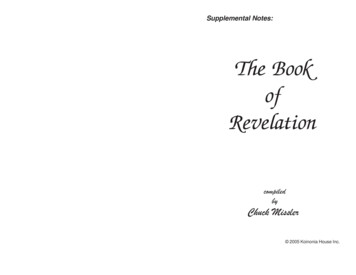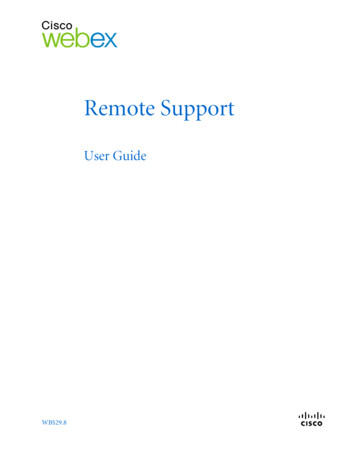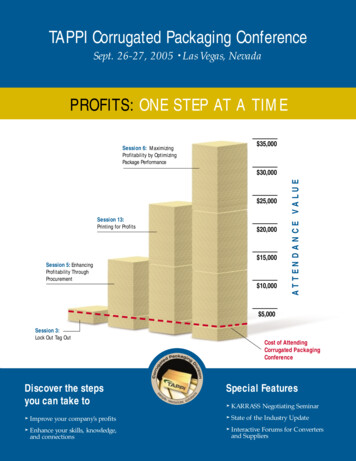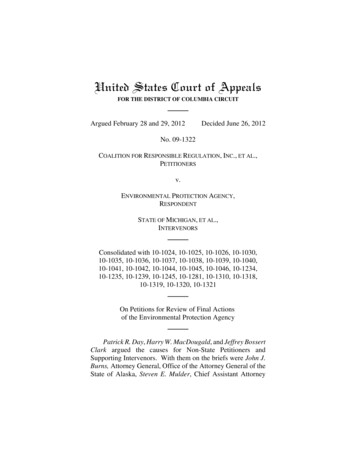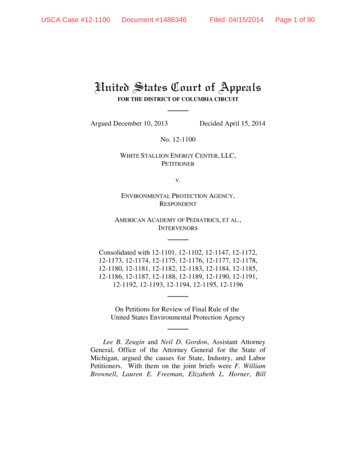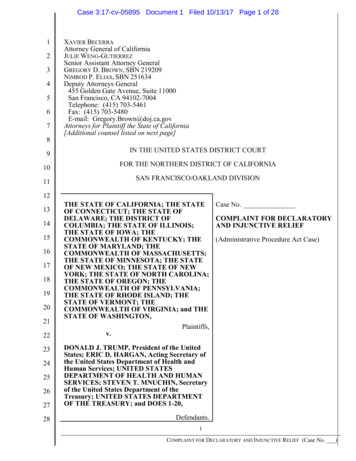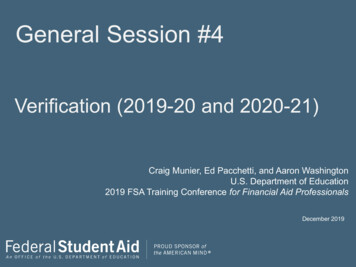
Transcription
General Session #4Verification (2019-20 and 2020-21)Craig Munier, Ed Pacchetti, and Aaron WashingtonU.S. Department of Education2019 FSA Training Conference for Financial Aid ProfessionalsDecember 2019
Key Staff Introductions Craig Munier, Policy Liaison andImplementation Aaron Washington, Policy, Planning andInnovation Ed Pacchetti, Customer Analytics2
Agenda Verification History 2019-2020 Verification 2020-2021 Verification Hot Topic3
Verification History Program Integrity regulations effectivefor the 2012-2013 award year Added verification groups New data elements and verificationgroups have been added and deletedover the last six years4
2019-2020 VerificationElectronic Announcement-Changes to 2018-2019 and2019-2020 Verification Requirements Income Tax Return Alternative documentation for Verification ofNonfiling 819and1920VerificationReq.html, January 9, 2019
2019-2020 VerificationResources 6Federal Register Notice of Information to be Verified for the 2019-2020Award Year https://ifap.ed.gov/fregisters/FR032818.html, March 28, 2018Dear Colleague Letter GEN 18-03 https://ifap.ed.gov/dpcletters/GEN1803.html, March 29, 20182019-2020 FAFSA Verification Suggested Text gestedTextPackage1920.html, June 8, 20182019-2020 ISIR Guide 20192020.html, September 6, 2018IRS Announced Updated Tax Transcript Redacting SensitiveInformation atedTaxTranscriptsRedactSenInfo.html, October 4, 2018
2019-2020 VerificationResources 7Verification Q & As ing/2009/verification.html2019-2020 EDE Technical Reference inal.html,July 30,2018Electronic Announcement-Changes to 2018-2019 and 2019-2020Verification Requirements 19and1920VerificationReq.html, January 9, 20192019-20 Application and Verification Guide 2019-2020 COD Technical Reference f1920.html, November 19, 2018
2020-2021Verification8
2020-2021 Verification9 Same data items No changes to the verification tracking groups Acceptable documentation in the Federal RegisterNotice published May 24, 2019 Suggested text meets regulatory requirements
2020-2021 Verification2018 Income Information for Tax Filer (V1 and V5)10 Adjusted Gross Income (AGI) U.S. Income Tax Paid Untaxed Portions of IRA Distributions and Pensions IRA Deductions and Payments Tax Exempt Interest Income Education Credits
2020-2021 Verification2018 Income Information for Nontax Filer(V1 and V5) Income earned from work11
2020-2021 Verification12 Number of household members (V1 and V5) Number in college (V1 and V5) High School completion status (V4 and V5) Identity/Statement of Educational Purpose(V4 and V5)
2020-2021 Verification Filing extension beyond automatic six-month extension for 2018 tax year A copy of the IRS’s approval of an extension beyond the automatic sixmonth extension for tax year 2018; Verification of nonfiling from the IRS dated on or after October 1, 2019; A copy of IRS Form W–2 for each source of 2018 employment incomereceived or an equivalent document; and If self-employed, a signed statement certifying the amount of AGI and U.S.income tax paid for tax year 2018.Note: If an institution requires that, after the income tax return is filed, anindividual granted an extension submit tax information, the institution must usethat tax information once the tax return is submitted to the IRS to reverify theincome and tax information reported on the FAFSA .13
2020-2021 VerificationVerification of Nonfiling (VNF) IRS documents that clearly indicate that the IRS does nothave a tax return record on file for the tax year areacceptable for VNF Verification of nonfiling from the IRS must be provided for(1) independent students (and spouses, if applicable) andparents of dependent student who did not file and are notrequired to file a 2018 income tax return and (2) individualswho are required to file a 2018 IRS income tax return buthave not filed because they have been granted a filingextension beyond the automatic six-month extension14
2020-2021 VerificationRequirement for Individuals Eligible for an Auto-ZeroExpected Family Contribution (EFC)For dependent students-15 The parents’ Adjusted Gross Income (AGI) if the parentswere tax filers The parents’ income earned from work if the parentswere nontax filers; and The student’s high school completion status andidentity/statement of educational purpose, if placed inVerification Tracking Group V4 or V5
2020-2021 VerificationRequirement for Individuals Eligible for an Auto-ZeroExpected Family Contribution (EFC) 16For independent students The student’s and spouse’s AGI if they were tax filers; The student’s and spouse’s income earned from work if theywere non tax filers; The student’s high school completion status andidentity/statement of educational purpose, if placed inVerification Tracking Group V4 or V5; and The number of household members to determine if theindependent student has one or more dependents other thana spouse
IRS Data Retrieval Tool (DRT) 2020-2021 IRS DRT function is available for the 2020-2021 FAFSAprocessing year All DRT data continues to be encrypted, FAFSA applicants cannotmake corrections, only institutions will be able to makecorrections IRS data field flags identify what, if any, information was changed IRS DRT is mobile ready17
Rollover18 If the DRT transfers a non-zero amount into the untaxedpension or IRA distribution field, the applicant will be able toreport the amount of rollover and the Central ProcessingSystem (CPS) will subtract it The IRS Data Field Flag will be “2” – Field changed by userprior to submission of application To complete verification of this item, collect a signed statementcertifying that the untaxed pension or IRA distributioncontained a rollover
Amended Tax Returns 2020-2021IRS Request Flag Value of 07 19Obtain a signed copy of the IRS Form 1040X or documentation fromthe IRS that include the change(s) made to the tax filer’s 2018 taxinformation, in addition to one of the following: IRS DRT information on the ISIR record with all tax informationfrom the original tax return; or An IRS Tax Return Transcript (that will only include info from theoriginal tax return and does not have to be signed), or any otherIRS tax transcript(s) that include all the income and taxinformation required to be verified
Report V4 and V5 Verification Results Reporting V4 and V5 verification results in FAAAccess to CPS online continues to be in effect for2020-2021 Institutions need to select the proper award year forwhich they are providing results20
Reminder An applicant may move from Verification Tracking Group V1 orV4 to group V5 based on corrections made to her or his CPSrecord or on other information available to the Department Electronic Announcement Changes in Verification 103116ChangesinVerificationTrackingGroup.html, October 31, 2016 21An applicant can be selected for verification throughout theaward year based on an update to the FAFSA
2020-2021 VerificationResources22 Federal Register Notice of Information to be Verified for the2020-2021 Award Yearhttps://ifap.ed.gov/fregisters/FR052419.html, May 24, 2019 Dear Colleague Letter tml, June 7, 2019 2020-2021 FAFSA Verification Suggested icationSuggestedTextPackage20202021.html, July 31, 2019 Electronic Announcement, November 26, 2019, 2020-2021FAFSA Verification-IRS Tax Return Transcript Matrix
Verification Rates23
Verification Rates Using a new Machine Learning Model (MLM) tochoose FAFSA filers for verification. A smarter model for choosing FAFSA filers. Traditionally, around 30% of FAFSA filers overallwere chosen for verification. Since October 1, 2018,around 22% of filers were chosen for verification. Selected about 900,000 fewer FAFSA filers for the19-20 FAFSA when compared to the 18-19 FAFSA.24
Verification RatesWhy choose 22% of FAFSA filers for verification? A cost-benefit analysis showed that verifying 22% ofFAFSA applicants resulted in the highest return inimproper payments. Verifying the riskiest of filers means the return inimproper payments prevented is greater than thecost. Results in reduced improper payments AND reducedburden to colleges and universities AND reducedburden to students and families.25
Verification RatesHow do we get to a lower selection rate? The Machine Learning Model (MLM) chooses FAFSAfilers based on a risk score. FSA also chooses a small sample to be a controlgroup and a random sample as a treatment group. Overall selection rate is just over 22%.26
Verification RatesWhy didn’t FSA lower the verification rate sooner? Verification is a balancing act between burden onstudents and families, the need to limit improperpayments, and being mindful of the administrativeburden on colleges and universities. Improper payments are defined as a FAFSA filer gettingmore OR less federal aid than they are eligible to receivedue to error. Only with the new technology of the Machine LearningModel could FSA lower verification rates while controllingimproper payments.27
Verification RatesHow did the new model do on the recovery ofimproper payments? The MLM model prevents the same percentage ofimproper payments as the previous model, whileverifying far fewer applicants. FSA’s conservative estimate indicates that thereduction in the verification rate has reduced theburden on colleges and universities.28
Verification RatesWhat impact did the reduction of verificationrates have on verification melt? Verification melt is the term used when a FAFSA filerchosen for verification drops out of the process andthus, is not able to access federal aid. FSA estimates verification melt to be 11% of filerschosen for verification, but other estimates putverification melt higher. When fewer filers are selected for verification,verification melt decreases as well.29
Verification RatesWhat is the impact of a reduced verification rate? Verify about 900,000 fewer FAFSA filers for the 19-20FAFSA in comparison to the 18-19 FAFSA. A verification melt rate of 11% means that nearly100,000 (99,000) more students may continue theprocess and receive federal aid that helps them to accesshigher education. If the verification melt rate is higher (some estimates putit as high as 25%) that number climbs to 225,000students who will now access federal aid to fund theirpostsecondary education.30
Verification RatesWhat are FSA’s goals for verification? Reducing the burden of verification on institutions,and on students and families while responsiblycontrolling for improper payments. Machine Learning Model is retrained every year.31
Hot Topic32
New IRS Tax Forms for 2018 Tax Year New Tax Form 1040 shortened/simplified (postcard size) Old Tax Form 1040 line items moved to new Schedules 1 - 6 Tax Forms 1040A/1040EZ Eliminated Tax Form Schedule 1 used as the proxy for same purpose that 1040A/1040EZ hadfor Auto-Zero and Simplified Needs Test eligibility33
New IRS Tax Forms for 2018 Tax Year Tax Form Schedule 1 proxy exceptions would have allowed 1040 filers to still beeligible to file 1040A.34
New IRS Tax Forms for 2018 Tax Year Tax Form Schedule 1 proxy exceptions would have allowed 1040 filers to still beeligible to file 1040A.35
New IRS Tax Forms for 2018 Tax Year New Tax Transcript template Accommodates tax information for both the old (2017 and prior)tax forms and the new (2018 and subsequent) tax forms Combines old tax lines and new tax lines into one transcript Tax information/data should only appear on corresponding taxdata line for applicable tax year36
2020-2021 Tax Return Matrix Significant changes to IRS tax form line items for2018 tax forms Electronic Announcement, November 26,2019,2020-2021 FAFSA Verification-IRS Tax ReturnTranscript Matrix Matrix no longer references IRS forms 1040A and1040-EZ Values associated with a tax item that includes “PerComputer” must be used for verification even ifdifferent that what was reported by the tax filer37
ABLE AccountsClarification that FAFSA reported Investments do not include “Achieving a Better LifeExperience” (ABLE) accounts.38
Acceptable Documentation An institution may request applicants submit a tax transcript as documentationof income and tax information A signed copy of the income tax return is also acceptable An institution may not require a tax transcript in lieu of a signed copy of theincome tax return unless the institution has concerns about the validity of thetax return submitted In those circumstances the institution may require a tax return transcript orother documentation specified in the annual Federal Register notice The institution must document the reason why the income tax return was notacceptable39
Craig Muniercraig.munier@ed.govEd Pacchettied.pacchetti@ed.govAaron Washingtonaaron.Washington@ed.gov40
A copy of IRS Form W–2 for each source of 2018 employment income received or an equivalent document; and If self-employed, a signed stateme

